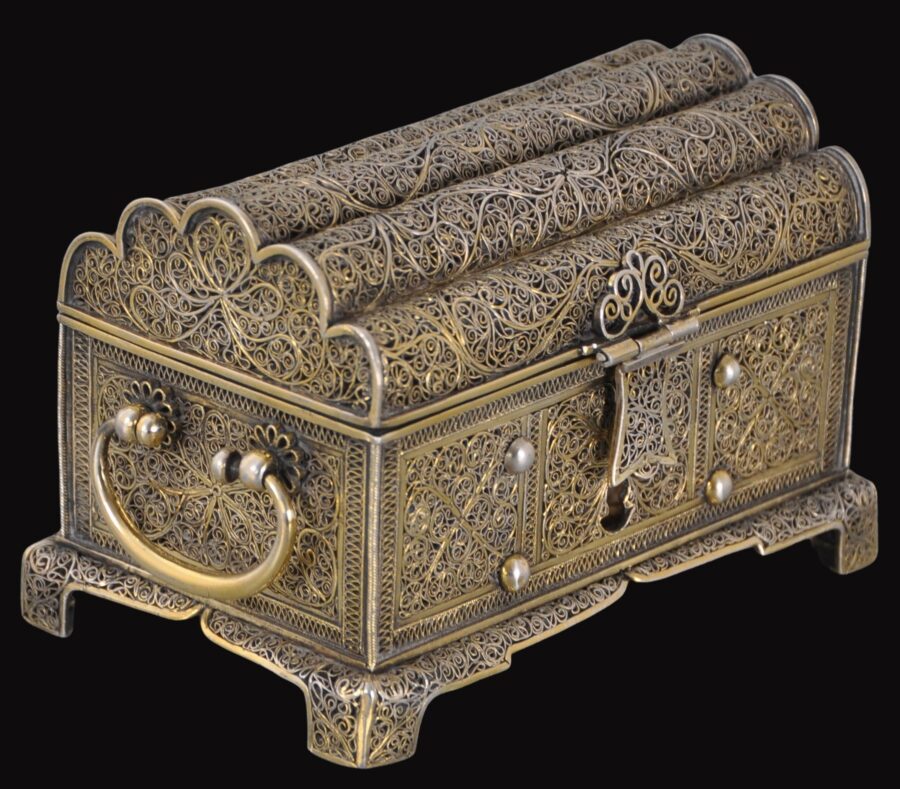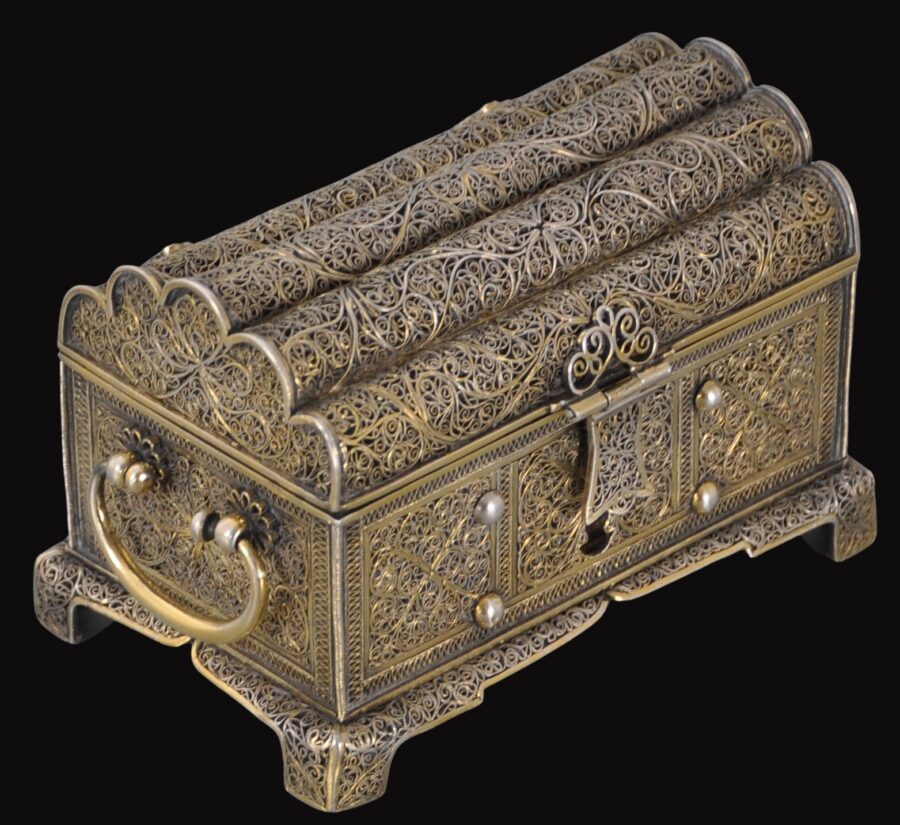This beautiful, well-proportioned small box or chest is made almost entirely of gilded silver filigree. The filigree comprises a mixture of flatter wires and particularly fine, whispy wires arranged in scrolls. Zig-zag type borders are present which typically is associated with filigree work produced in the Dutch East Indies. The box has a rolling, crenulated, hinged lid. The box sits on four filigree legs and has an elegant filigree skirting all the way around.
The original gilded silver lock is present, as is the filigree lock latch. The lock is held in place with four rivets with the hemispherical rivet caps visible on the front of the box. The key is no longer present. The original gilded silver internal chains that connect the lid to the base to support the lid when it is open are also present.
A solid-cast, gilded silver ‘C’-shaped handle is on each side.
The quality of the box is further suggested by the base which also is of gilded silver filigree arranged as three panels and of a fineness that matches the rest of the box.
Similar boxes are illustrated in Curvelo (2008, p. 54) and Jordan (1996, p. 212). The former describes the box as being from 16th-17th century Goa, and the latter attributes its example to 17th century or later, India. Another illustrated in Piotrovsky (2006. p. 43) and in Russia’s Hermitage Museum, is attributed to the mid-17th century, to Goa (?) and with the ‘assistance of Chinese masters (?)’. None of these examples are gilded.
It is more likely that the box was produced in the Dutch East Indies. Veenendaal (2014, p. 122, 125) illustrates two examples of similar form which he attributes to West Sumatra, Dutch East Indies, circa 1700. This is the more likely correct attribution.
Items in silver filigree of this type were commissioned by the Dutch East India Company (VOC) and its agents from silversmiths in the Dutch East Indies, not just for European clients, but also for clients in India. Such items were then later found in India and were then (incorrectly) attributed to local silversmiths,
The main objective of the VOC was to bring spices from Asia to Europe. But the VOC also established a complex series of intra-Asia trade networks whereby items were purchased in one part of Asia to be sold in another for profit. One study identifies 1,059 ships in the employ of the VOC which routinely took part in trade within Asia between 1595 and 1660 (Parthesius, 2010, p. 13). Textiles were a mainstay of intra-Asia trade but other consignments included luxury goods, timber, Chinese porcelain, and even elephants. Items of silver were produced in and near Batavia at the behest of the VOC and there was a history of silver filigree production in the area. William Marsden in his treatise on Sumatra first published in 1784 includes an extensive description of gold and silver filigree work carried out in Sumatra, with the observation that: ‘there being no manufacture in that part of the world, and perhaps I might be justified in saying, in any part of the world, that has been more admired and celebrated than the fine gold and silver filigree of Sumatra. This indeed is, strictly speaking, the work of the Malayan inhabitants’. He adds that ‘The [local] Chinese also make filigree, mostly of silver, which looks elegant, but wants likewise the extraordinary delicacy of the Malayan work.’ Sumatra was an important market for Indian-made textiles imported by the VOC. Pepper and gold were among the goods that the VOC received in payment. Undoubtedly, filigree work was too, all of which would have been trans-shipped through Batavia.
The box here is in excellent condition. It is the only example of this form of which we are aware that has been gilded – the gilding has softened over the years and has a particularly beautiful hue.
References
Backman, M., Malay Silver and Gold: Courtly Splendour from Indonesia, Malaysia, Singapore, Brunei and Thailand, River Books, 2024.
Curvelo, A., et al, The Orient Museum, Lisbon, Reunion des Musees Nationaux, 2008.
Jordan, A. et al, The Heritage of Rauluchantim, Museu de Sao Roque, 1996.
Marsden, W., The History of Sumatra: Containing an Account of the Government, Laws, Customs and Manners of the Native Inhabitants, with a Description of the Natural Productions, and a Relation of the Political State of that Island, 1784.
Parthesius, R., Dutch Ships in Tropical Waters: The Development of the Dutch East India Company (VOC) Shipping Network in Asia 1595-1660, Amsterdam University Press, 2010.
Piotrovsky, M. et al, Silver: Wonders from the East – Filigree of the Tsars, Lund Humphries/Hermitage Amsterdam, 2006.
Veenendaal, J.,Asian Art and the Dutch Taste, Waanders Uitgevers Zwolle, 2014.










